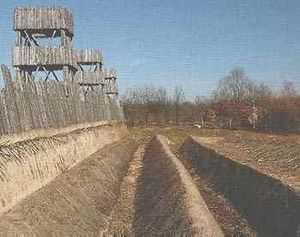Investment (military)

_1627_-_Grolla_Obsessa_et_Expugnata_(J.Blaeu).jpg)
Investment is the military tactic of surrounding an enemy fort (or town) with armed forces to prevent entry or escape.[1][2]
A circumvallation is a line of fortifications, built by the attackers around the besieged fortification facing towards the enemy fort (to protect the besiegers from sorties by its defenders and to enhance the blockade).[3][4] The resulting fortifications are known as 'lines of circumvallation'.[5] Lines of circumvallation generally consist of earthen ramparts and entrenchments that encircle the besieged city. The line of circumvallation can be used as a base for launching assaults against the besieged city or for constructing further earthworks nearer to the city.
A contravallation may be constructed in cases where the besieging army is threatened by a field army allied to the enemy fort.[6] This is a second line of fortifications outside the circumvallation, facing away from the enemy fort. The contravallation protects the besiegers from attacks by allies of the city's defenders and enhances the blockade of the enemy fort by making it more difficult to smuggle in supplies.[7]
The Siege of Alesia which took place in September 52 BC is one of the most famous investments in history. Julius Caesar in his Commentaries on the Gallic War describes his textbook use of the circumvallation and contravallation to defeat the Gauls under their chieftain Vercingetorix. Thucydides notes the role circumvallation played in the Spartan siege of Plataea during the initial stages of the Peloponnesian War, 429 BC.
The basic objectives and tactics of a military investment have remained the same in the modern era. During the Second World War there were many sieges and many investments. One of the most famous sieges of WWII which demonstrated the tactical use of investment was the siege of Stalingrad. During the first half of the siege the Germans were unable to fully encircle the city, so the Soviets were able to get men and supplies into the city across the Volga River. In the second half of the battle, the complete investment of Stalingrad by the Soviets (including air space which prevented the construction by the Germans of an adequately large airbridge) eventually forced the starving Germans inside the city to surrender.
See also
References
- ↑ invest Merriam-Webster
- ↑ "4. Milit. The surrounding or hemming in of a town or fort by a hostile force so as to cut off all communication with the outside; beleaguerment; blockade" (Oxford English Dictionary: investment, n. Second edition, 1989; online version December 2011. Entry/99052. Earlier version first published in New English Dictionary, 1900).
- ↑ Definition of circumvallation www.yourdictionary.com
- ↑ Oxford English Dictionary: circumvallation, n. Second edition, 1989; online version December 2011. Entry/33402. Earlier version first published in New English Dictionary, 1889.
- ↑ Lines of Circumvallation/Contravallation and Interior/Exterior lines of communication
- ↑ Definition of contravallation www.yourdictionary.com
- ↑ Oxford English Dictionary: contravallation, n. Second edition, 1989; online version December 2011. Entry/40491. Earlier version first published in New English Dictionary, 1893.